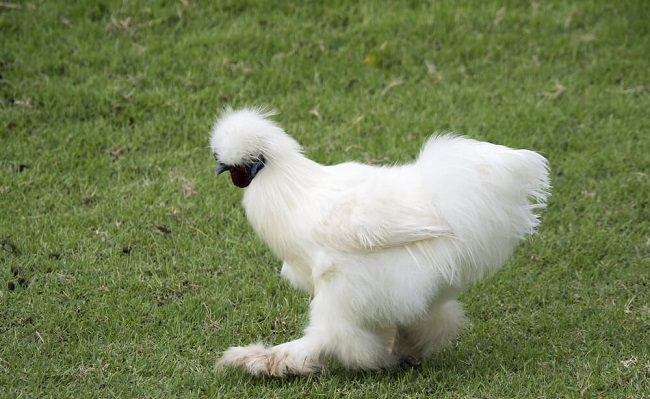Silkie chickens are renowned not just for their fluffy, fur-like plumage, but also for their intriguing variety of colors. Each shade adds a unique flair to the distinct appearance of these fascinating birds.
This comprehensive guide explores 10 types of Silkie Chicken Colors and delves into the genetic factors behind these captivating color variations.

The 10 Striking Silkie Chicken Colors
Here is some of the Silkie Chicken Colors:
Read Also:
1. White
White is the most common color in Silkie chickens. It gives them a pure, fluffy appearance that resembles a cotton ball. The white color is dominant, masking other colors that a Silkie chicken might carry.
2. Black
Black Silkies showcase an impressive, glossy black plumage that often gleams with a greenish-blue iridescence in the sun. This color, like the white, is also dominant.
3. Blue
Blue Silkie chickens possess a cool, greyish-blue color, giving them a somewhat mystical appearance. This color occurs due to the dilution of black pigmentation.
4. Splash
Splash Silkies have a unique pattern of blue and white splashes on their plumage, giving them a charming speckled appearance. This color is usually a result of breeding two Blue Silkies together.
5. Buff
Buff Silkies display a beautiful, warm, golden-brown color. This color is not dominant, and thus can sometimes be difficult to breed for consistency.
6. Red
Red Silkies have a reddish-brown color that gives them a distinguished look. They’re relatively rare and are often bred through specific color breeding programs.
7. Partridge
Partridge Silkies have multi-colored feathers arranged in a complex pattern, featuring gold, brown, and black hues. This color is sex-linked, allowing the differentiation between male and female chicks.
8. Gray
Gray Silkies have a muted, sophisticated color, which is a diluted version of black, making them less common than Black or Blue Silkies.
9. Lavender
Lavender Silkies have a delicate purple-grey color, a very rare and sought-after shade achieved through specific breeding programs.
10. Cuckoo
Cuckoo Silkies have a striking black-and-white barred pattern, similar to the Cuckoo Maran chicken breed. This color variety is quite rare in Silkies.
The Science Behind Silkie Chicken Color Variations
Silkie chicken color variations occur due to the interaction of several genes that control pigmentation.
Three types of pigments are responsible for the color in chicken feathers: eumelanin (black/brown pigmentation), phaeomelanin (red/yellow pigmentation), and porphyrins (green/red pigmentation).
Different combinations of these pigments, controlled by genetic factors, result in the wide array of Silkie Chicken Colors.
Breeding Silkie Chickens for Color
Breeding Silkie chickens for specific colors can be a rewarding and fascinating endeavor. However, it’s important to note that color breeding is a complex process that requires patience and understanding of the basic principles of genetics.
Crossing Colors
While it’s possible to cross different colors of Silkies, doing so without understanding the genetic implications can result in unpredictable and often non-standard colors. To maintain the color purity of Silkie chickens, breeders usually breed birds of the same color.
Sex-linked Colors
Certain colors, like Partridge, are sex-linked, meaning that male and female chicks can be differentiated by their color at hatching. This can be helpful for breeders who want to maintain a specific ratio of hens to roosters in their flock.
The Significance of Silkie Chicken Colors in Shows
In Silkie chicken shows, the color of the bird plays a significant role in judging. The American Poultry Association recognizes specific colors, including Black, Blue, Buff, Gray, Partridge, and White.
Breeders aiming to show their birds should adhere to these recognized colors for the best chance of success.
Caring for Different Silkie Chicken Colors
Regardless of their color, all Silkie chickens require similar care. This includes a balanced diet, clean and spacious housing, regular health checks, and plenty of socialization.
However, lighter-colored Silkies, such as White and Splash, may require extra grooming to keep their feathers looking their best.
Read Also:
Conclusion
The world of Silkie Chicken Colors is a vibrant and fascinating one, with each shade adding to the unique charm of this beloved breed.
Whether you’re a Silkie chicken breeder or an enthusiast, understanding these color variations and their genetic basis can deepen your appreciation for these delightful birds.
Hopefully, our guide to the 10 types of Silkie Chicken Colors and the science behind them has enlightened you and will help you make informed choices in your Silkie chicken journey.
























